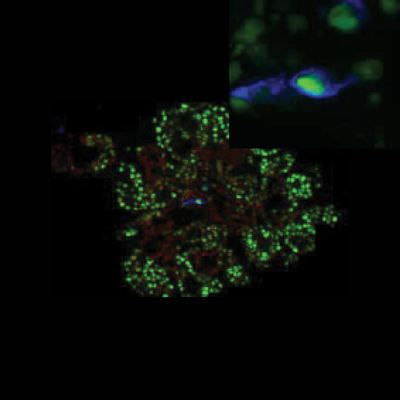Modern biology has focused on purifying different cells from the body and growing them in culture – often in flat layers on hard plastic dishes that do little to represent the complexity of human biology.
To address this challenge, two branches of 3D cell culture technologies have emerged.

Scaffold Techniques
use solid scaffolds, hydrogels and other biomaterials to support individual cells growing in 3D.

Scaffold-Free Techniques
use low adhesion plastics, hanging drops and magnetic forces to bring multiple cells in contact with each other.
For making organoids reproducible and available, we need to combine these two techniques.
Our Solution
We developed the Gri3D® platform that combines 3D aggregation with biomaterials to create a 3D culture according to the current gold standard of 2D cell culture.
3D in 2D
With Gri3D® have your complete 3D culture in a single focal plane.
Accuracy & Scalability
With Gri3D® generate hundreds of uniform organoids at once.
Hydrogels
Allow survival and growth of even your most sensitive stem cells.
All in One
With Gri3D® use only one platform for your entire organoid protocol.
The Gri3D® platform allows the standardized growth of organoids in large scale.

[button color=”see-through-2″ hover_text_color_override=”#fff” size=”large” url=”#quote-form” text=”Get a Quote” color_override=”#4725a8″ image=”linecon-icon-mail”]
[button color=”see-through” hover_text_color_override=”#4725a8 image=”default-arrow” size=”medium” url=”https://sunbioscience.com/wp-content/uploads/Test-Gri3D.pdf” text=”Size Guide” color_override=”#4725a8″]
For information on our Gri3D® platform, to discuss your specific needs and pricing, please contact us.
Success So Far..

Retina
Using pluripotent stem cells, we are growing retinal organoids.
Read More [icon color=”Accent-Color” size=”tiny” image=”fa-angle-up”]
These retinal organoids, also called Optic Cups, develop into layered retinal tissues with a ganglion cell layer, an inner nuclear layer and an outer nuclear layer. These Optic Cups express Crx, an early marker for cones and rods, the light-sensing cells of the eye.

Gut
Using adult stem cells, we are growing intestinal organoids.
Read More [icon color=”Accent-Color” size=”tiny” image=”fa-angle-up”]
These intestinal organoids, harbor the functional cells of the intestinal epithelium :
Paneth cells producing antimictobial peptides, Goblet cells producing the mucus of the gut, Enteroendocrine cells producing hormones, Enterocytes responsible for nutrient absorption

Brain
Using pluripotent stem cells, Gri3D® is used to grow cerebral organoids.

Pancreas
Using fetal stem cells, Gri3D® is used to grow pancreatic organoids.

Inner Ear
Using pluripotent stem cells, Gri3D® is used to grow otic organoids.
Applications
Organoids can be grown from the stem cells of each person. They open the door to personalized medicine, where we can understand and test the differences from one patient to the next.

Personalized Testing
For pharmaceutical companies, personalized testing means that drugs that so far failed to show efficacy for the global patient population could be marketed for the specific pool of patients where they do work.
For patients, personalized testing means to pre-select the medications that work for them, resulting altogether in more effective and cost-effective therapies.

